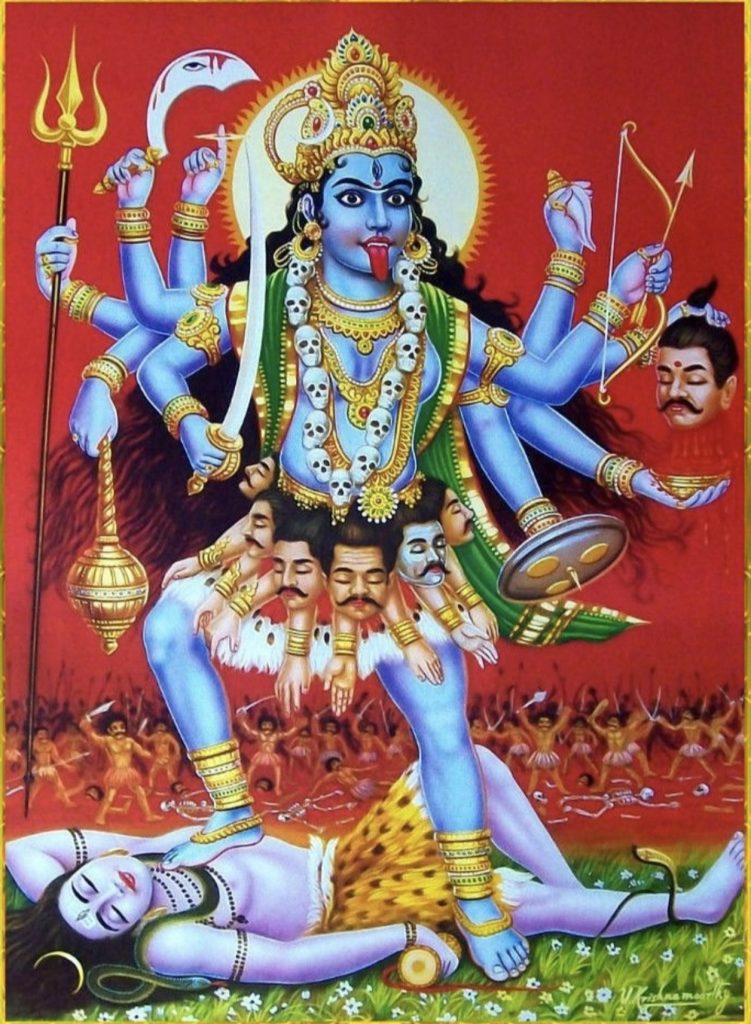Why Do Western Women Love Kali? ~ Maya Devi Georg
I have always been fascinated by Kali. And I am not alone. Long ago I noticed the attraction to Kali I shared with other spiritual western women. We all seem to have at least one image of the Indian goddess in our homes or practice spaces. But what is the source of that fascination? Why do we all seem to love Kali?
The images almost always depict Kali on a battlefield, trampling Shiva. Her tongue lolling, she wears a garland of human heads and a skirt of human arms. In one of her many arms she holds a crescent shaped sword, in another a still bleeding human head. She seems fearless and fearsome, as though intoxicated by her power. The images portray violence and evoke rage.
The depictions are of a destructive force, trampling demons and gods alike. This seemingly violent iconography of Kali is what attracts western women. They wish they could embody her strength and potential for violence, to terrify in turn what terrifies them.
To many women in the west, Kali is a feminist icon. She is trampling the patriarchy, not Shiva. She is a symbol of rebellion, as she defies gender roles, and engages in a level of violence historically only perpetrated by men.
This fascination with Kali demonstrates the desire for female empowerment and resistance, while also reflecting a deeper, often unspoken yearning for a reversal of deeply entrenched societal injustices. Kali becomes an archetype that embodies strength, autonomy, and the ability to confront and dismantle oppressive structures. In a world where women have historically been marginalized and subjected to violence, Kali’s fierce independence and formidable power resonates as a beacon of resistance and liberation.
And women are more significantly more likely to experience violence at the hands of men than vice versa. This is a statistical reality, not just in the west but also in the east. So why isn’t Kali viewed through the same lens in the East? Why, when misogyny is universal, is Kali seen so differently between the two cultures?
The western view of Kali is reliant on the literal interpretation of her images and the stories they tell. However, this literal interpretation goes contrary to how Kali is viewed in her native India. In India she is seen as as a divine mother, nurturing and protective, fostering creativity and compassion. She is time, giving and taking in equal measure, but doing so as mother would to her beloved children. And what she takes away is our attachments, clearing the obstructions to our self-realization and leading us to enlightenment.
In the west, is Kali viewed with traits traditionally attributed to men, power, strength, and domination, all depicted as violence and bloodshed. But the violence and bloodshed seen in her images and the stories they tell are metaphors that represent a different kind of power. The metaphor of the decapitation symbolizes the weakening of identity and ego attachments, while the dismembered arms represent the release of our physical attachments. These are symbolic representations of our own esoteric and spiritual practices, and are most accessible when we connect to our own divine feminine.
The patriarchy has enshrined men’s power and authority which has manifested as violence and domination. Kali is its antidote.
Kali’s power is in her femininity, in her love, compassion, and mercy. This care is to protect us not from literal demons, but from our own demons, those memories and emotions that haunt us. Kali is the mama bear that protects us from ourselves. Her trampling of Shiva, the embodiment of ultimate consciousness, can be viewed in several ways. One way is to see her become the field in which consciousness can be experienced, that is, the universe that gave us life, and will ultimately take that life. Similarly, her trampling of Shiva can viewed as her killing a god. This represents time, as in time all things cease to exist. Kali is a mother, she gives us life, and in doing so gives us a world of opportunities afforded to us by simply being alive.
By honoring Kali, with puja, mantra, or even by bringing our awareness to her likeness, we kindle the power she represents that exists in us all. This is the power of the feminine, life-giving and full of a creativity that is driven by compassion and love. While the Western interpretation of Kali offers solace as we confront the various cruelties in life, embracing the complete and authentic essence of feminine power allows us to embody it, thereby transforming both ourselves and the world around us.




